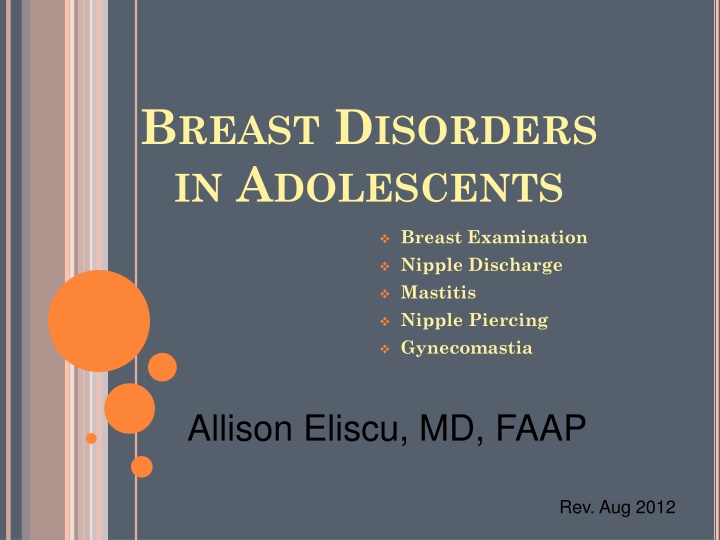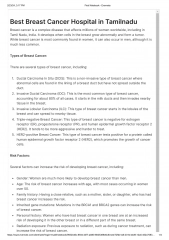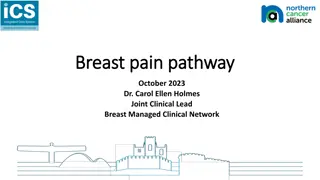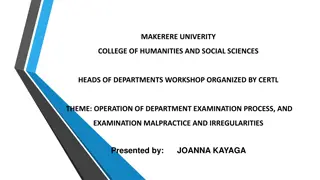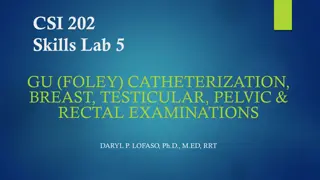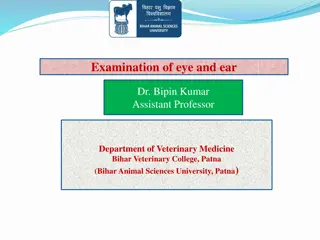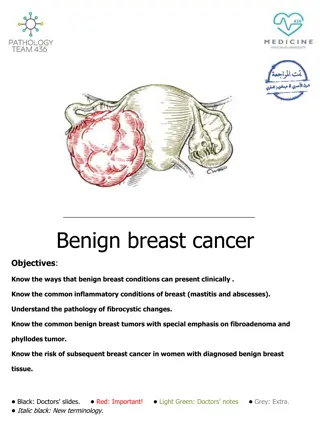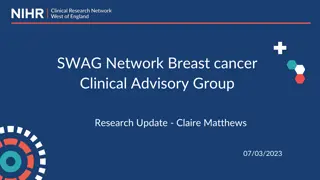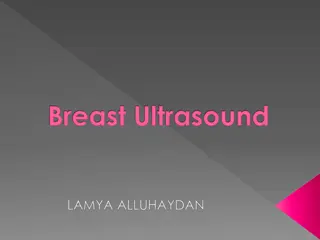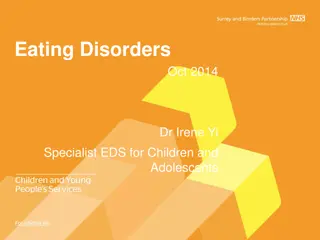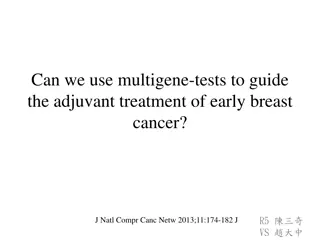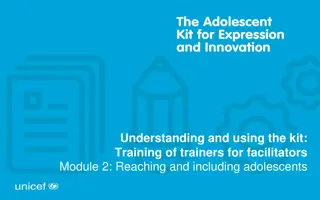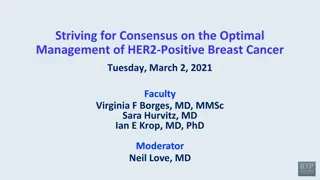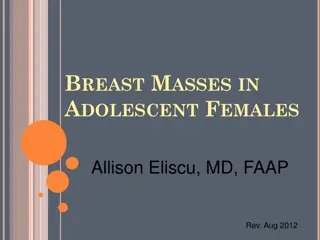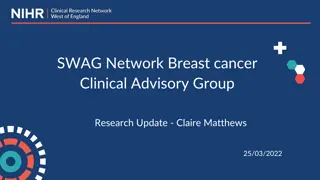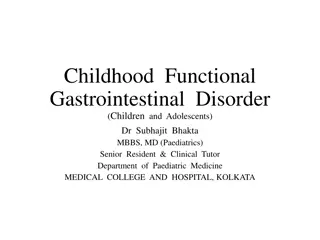Breast Disorders in Adolescents: Examination and Management
Adolescents may experience various breast disorders including nipple discharge, mastitis, and gynecomastia. Learn how to perform a breast exam, understand nipple discharge history, differential diagnosis, and management options. Stay informed about self-examination and early detection practices to promote breast health.
Download Presentation

Please find below an Image/Link to download the presentation.
The content on the website is provided AS IS for your information and personal use only. It may not be sold, licensed, or shared on other websites without obtaining consent from the author.If you encounter any issues during the download, it is possible that the publisher has removed the file from their server.
You are allowed to download the files provided on this website for personal or commercial use, subject to the condition that they are used lawfully. All files are the property of their respective owners.
The content on the website is provided AS IS for your information and personal use only. It may not be sold, licensed, or shared on other websites without obtaining consent from the author.
E N D
Presentation Transcript
BREAST DISORDERS IN ADOLESCENTS Breast Examination Nipple Discharge Mastitis Nipple Piercing Gynecomastia Allison Eliscu, MD, FAAP Rev. Aug 2012
HOW TO DO A BREAST EXAM IN AN ADOLESCENT FEMALE Inspect skin for abnormalities Supine position with ipsilateral arm above head Use flat finger pads over entire breast surface Follow pattern to cover ENTIRE breast Compress areola to express discharge Palpation for lymphadenopathy Axillary, supraclavicular, infraclavicular Suggested patterns to follow during breast examination to insure entire breast examined
BREAST SELF-EXAMINATION Controversial Impact on cancer diagnosis, death, and tumor stage at diagnosis not proven We recommend monthly exams after 18 years old Become more familiar with their body Get used to self-exam early Should be performed monthly after period ends Inspect breasts in mirror for abnormality Arms by side, arms overhead, hands on hips Ipsilateral arm above head, palpate entire breast May be easier in shower with soapy hand
NIPPLE DISCHARGE - HISTORY Discharge Characteristics Unilateral or bilateral Spontaneous expression or requires stimulation Color and consistency of discharge Milky, bloody, serosanguinous Painful? Miscellaneous Last menstrual period Medication use Drug use Review of Systems Headache, tunnel vision Temperature intolerance, energy level, constipation Fever
NIPPLE DISCHARGE DIFFERENTIAL DIAGNOSIS Milky discharge (galactorrhea) Excessive stimulation Pregnant or postpartum Recent abortion Prolactinoma Hypothyroidism - Most Common Cause of Galactorrhea Medication use (antipsychotics, oral contraceptives, opiates) Drug use (codeine, marijuana, morphine) Purulent discharge Infection Serosanguinous discharge Fibrocystic change Intraductal papilloma Nipple erosion or eczema Mammary duct ectasia Cancer (very rare in adolescence) Paget s Disease (very rare in adolescence)
NIPPLE DISCHARGE WORK UP & MANAGEMENT Work Up Urine HCG TSH, free T4 Prolactin LH, FSH Attempt to express discharge for culture Management Discontinue offending drugs Avoid excessive nipple stimulation Begin antibiotics if suspicious for infection Obtain ultrasound if mass palpable
MASTITIS Risk Factors Excessive stimulation Shaving Nipple piercing Trauma Organisms Most Common - S. aureus & Group A Streptococcus E. Coli, Pseudomonas, enterococcus, anaerobics possible but less likely
MASTITIS PHYSICAL EXAMINATIONAND MANAGEMENT Clinical Findings Swelling, erythema, warmth Induration Nipple discharge Fluctuance may be present (indicates abscess) Management Warm Compresses Antibiotic coverage (oral if well appearing) PO Dicloxacillin, keflex, clindamycin, bactrim IV Nafcillin, cefazolin, vancomycin, clindamycin Should have clinical improvement in 24-48 hours If abscess suspected will need incision and drainage
NIPPLE PIERCING Proper Care Wash with antibacterial soap twice daily Rotate jewelry Apply antibacterial ointment for 1 week Usually heals in 3-6 months Complications Superinfection Local cellulitis or abscess (usually Staph or Strep) Contraction of infection (Hepatitis B or C, HIV) Pain Bleeding Allergic reaction to metal Keloid formation May interfere with breastfeeding
GYNECOMASTIA Defined as breast tissue in males Differentiate from adipose tissue in obese males (pseudogynecomastia) Due to transient imbalance between estrogen and androgen Very common in adolescent males Average onset Tanner 3-4 (age 13 years old) More commonly bilateral (may be unilateral) Frequently asymmetric Usually self-resolves within 6-12 months
GYNECOMASTIA (CONTINUED) Differential Diagnosis Physiologic most common etiology in pubertal males Medications (Spironolactone, H2 blockers, TCAs, reglan, phenytoin, ace inhibitors) Drugs (Marijuana, alcohol, methamphetamines) Hyperthyroidism Tumors (testicular, adrenal) Management Screen for medication or drug use Reassurance Repeat examination in 6 months Work-up required if persisting >2 years
A 16 year old female presents to the office complaining of right sided breast pain which has been getting worse over the past day. On exam, you note erythema and edema with some yellowish nipple discharge. The affected area is extremely tender to palpation. The most likely diagnosis is A. Fibrocystic change B. Eczema C. Mastitis D. Mammary duct ectasia E. Prolactinoma
A 16 year old female presents to the office complaining of right sided breast pain which has been getting worse over the past day. On exam, you note erythema and edema with some yellowish nipple discharge. The affected area is extremely tender to palpation. The most likely diagnosis is A. Fibrocystic change B. Eczema C. Mastitis D. Mammary duct ectasia E. Prolactinoma
Answer: C. Mastitis tends to present with acute onset of pain with swelling, erythema, warmth, and induration on exam. Nipple discharge may also be present. Fibrocystic change tends to present with mild premenstrual tenderness with cords and lumps on exam but no erythema, edema, or discharge. Eczema is usually a subacute presentation with skin irritation, erythema, and prurtitis with or without mild nipple discharge. Mammary duct ectasia is a blockage of the subareolar duct which presents with sticky, multicolored nipple discharge which is nontender with minimal skin changes. Prolactinomas tend to present with bilateral milky nipple discharge without skin involvement.
A 13 year old male presents to the office complaining of breast enlargement over the past month. He denies nipple discharge or tenderness. He is not taking any medications and has never experimented with any drugs. On examination, you note 2cm breast bud under the right nipple and 1 cm on the left. He is Tanner Stage 2 for genitalia and has an otherwise normal exam. What is the most appropriate first step in management? A. Obtain a CT scan of the head B. Serum HCG C. Testicular ultrasound D. Urine toxicology screen for marijuana E. Reassurance that this is a normal occurrence
A 13 year old male presents to the office complaining of breast enlargement over the past month. He denies nipple discharge or tenderness. He is not taking any medications and has never experimented with any drugs. On examination, you note 2cm breast bud under the right nipple and 1 cm on the left. He is Tanner Stage 2 for genitalia and has an otherwise normal exam. What is the most appropriate first step in management? A. Obtain a CT scan of the head B. Serum HCG C. Testicular ultrasound D. Urine toxicology screen for marijuana E. Reassurance that this is a normal occurrence
Answer: E. Gynecomastia is an extremely common occurrence in young males, which usually begins during Tanner stage 2-3 and self resolves within 6-12 months. It is frequently asymmetric and usually nontender. Patients should be asked about the use of medications (such as antipsychotics, TCAs, spironolactone) or drugs (marijuana, alcohol, methamphetamine) which may cause gynecomastia. Since this patient is within the expected age range for the presentation of physiologic gynecomastia and has an otherwise normal exam, initial management should be reassurance with repeat examination in 6 months at which time the breast development should have stabilized or regressed. Work-up for malignancy is not recommended unless the patient develops other symptoms (galactorrhea, testicular mass, headaches, etc), the breast buds persist for longer than 2 years, or the onset of gynecomastia is in a prepubertal or postpubertal male.
Initial work-up for an adolescent female presenting with bilateral milky nipple discharge should include all of the following EXCEPT: A. TSH B. Prolactin C. Breast ultrasound D. Pregnancy test
Initial work-up for an adolescent female presenting with bilateral milky nipple discharge should include all of the following EXCEPT: A. TSH B. Prolactin C. Breast ultrasound D. Pregnancy test
Answer: C. Common etiologies for galactorrhea in adolescent females include hypothyroidism, prolactinomas, and pregnancy. Additionally, patients should be asked about excessive breast stimulation, medication use, and recreational drug use. Ultrasound of the breast is not part of the initial work-up unless a mass is palpated.
RECOMMENDED READING Breast concerns in the adolescent. ACOG Committee Opinion No. 350. American College of Obstetricians and Gynecologists. Obstet Gynecol 2006;108:1329 36. De Silva NK, Brandt ML. Disorders of the Breast in Children and Adolescents. Part 1: Disorders of growth and infections of the breast. J Pediatr Adolesc Gynecol. 2006 Oct;19(5):345-9. Mayers LB, Moriarty BW, Judelson DA, Rundell KW. Complications of Body Art. Consultant. 2002;42:1744- 52. Nordt CA, DiVasta AD. Gynecomastia in Adolescents. Curr Opin Pediatr. 2008 Aug;20(4):375-82.
